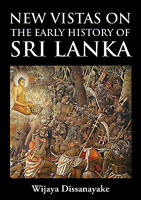The kernel of truth in deeply-entrenched cultural myths
View(s):Book facts: “New Vistas on the Early History of Sri Lanka ” – Wijaya Dissanayake (Vijitha Yapa). Reviewed by Tissa Devendra
Professor [of Psychiatry] Wijaya Dissanayake now joins distinguished medical doctors Nath Yogasundram and Anton Sebastian who who have produced scholarly works on our country’s history [also published by Vijitha Yapa]. His “New Vistas”, written in clear and simple language, is an excellent introduction to the layman of a scientific and unprejudiced approach to our history.

He is the first scholar who has commenced his work with the evolution of early man in Africa and ‘his’ beachcombing journey, over several millennia, to distant Australia while peopling, en route, our homeland which had not yet separated from the Indian land mass. I found it fascinating how the writer has woven the latest scientific discoveries to prove his thesis. Earlier studies of this human Odyssey tended to rely on palaentology and archaeology. To quote the author “During the past few decades, however, progress in the field of microbiology has led to the discovery and study of chromosomes and genes, of DNA …..giving new insights into biological evolution as well as the origins of humankind.”
His is a well researched study of the kernel of truth in the centre of deeply entrenched cultural myths. In his view the mythical ‘Yakkhas’ were earlier, civilised, settlers whose genes and culture mingled with later [Vijayan] settlers from various Aryan speaking regions of India and thus evolved into Sinhala people. The story of Pandkabhaya illustrates this development. Buddhist legend makes it clear that the ‘Nagas’ were another pre-Vijayan people who lived here.
Their name means their totem was the snake and the story of the Buddha’s intervention in their dispute clearly indicates they were a cultured and civilised people – though the absence of any writing, or artifacts, makes further study difficult. The prehistoric humans who first crossed the land bridge to come here have left much physical evidence such as megalithic structures, urn burials and middens of shell and bone from cave shelters. These are now being scientifically studied and, in time, will yield valuable data of the first peopling of our shores.
The hunter-gatherer Veddhas and the mysterious Nittaewo who lived in our forests from earliest times are described with understanding of their interaction with later more ‘civilised’ settlers
In speaking of the Vijayan settlement the author writes of, “The many faces of Vijaya” and delves into many alternative stories of earlier visitors/settlers and the different areas of the mainland they came from. It is now generally accepted that ‘Vijaya’ was not our sole progenitor but that there were many other wavelets and trickles of settlers from North India such as Gujarat, Bengal and other regions speaking mutually comprehensible ‘Aryan’ languages. Royal matrimonial alliances from various kingdoms were quite common – and persisted right up to the reign of lthe ast of our ‘Sinhala’ kings, Sri Wikrama Rajasinha.
In the global canvas he paints, the author draws our attention to similarities between the voyage of Vijaya and the Greek Odyssey – pointing us towards universal myths of mankind – like that of the Great Flood. Another parallel is that between the Oedipus story and Sinhabahu where killing the father has Freudian overtones.
The author makes it clear that as the Sinhala civilisation had the closest links with India it was most likely that the religious movements in the mainland percolated here and as such there would have been adherents of Buddhism [as well as Jainism] in Sri Lanka, well before the advent of Mahinda Thera which bestowed the royal imprimatur on Buddhism – thus placing its indelible stamp on our culture and civilisation.
Sri Lanka is placed, by the author, in the centre of a network of international trade and cultural activity. He describes the seaborne traffic from the Middle East and the Far East – of the Greek Kosmas, the great Chinese scholar Fa Hsien and King Bhatika Abhaya’s embassy to the Roman Emperor Claudius. It is a fascinating narrative.
I am grateful to Professor Wijaya Dissanayake for this well researched and extraordinarily informative book which deserves the widest readership.
Follow @timesonlinelk
comments powered by Disqus


